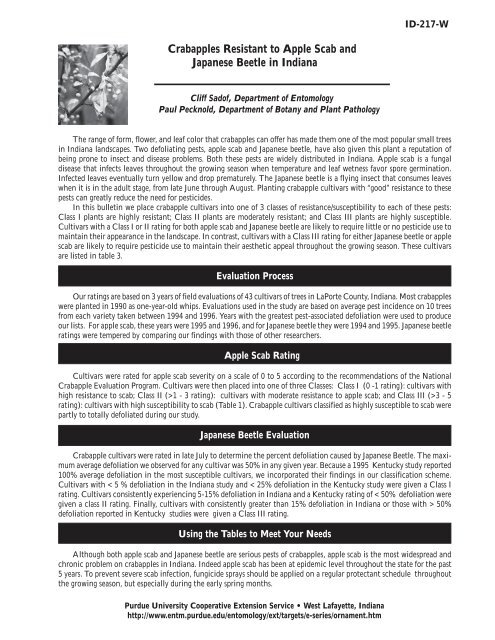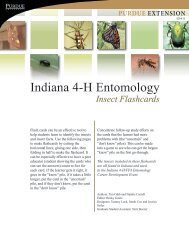Crabapples Resistant to Apple Scab and Japanese Beetle in Indiana
Crabapples Resistant to Apple Scab and Japanese Beetle in Indiana
Crabapples Resistant to Apple Scab and Japanese Beetle in Indiana
Create successful ePaper yourself
Turn your PDF publications into a flip-book with our unique Google optimized e-Paper software.
ID-217-W<br />
<strong>Crabapples</strong> <strong>Resistant</strong> <strong>to</strong> <strong>Apple</strong> <strong>Scab</strong> <strong>and</strong><br />
<strong>Japanese</strong> <strong>Beetle</strong> <strong>in</strong> <strong>Indiana</strong><br />
Cliff Sadof, Department of En<strong>to</strong>mology<br />
Paul Pecknold, Department of Botany <strong>and</strong> Plant Pathology<br />
The range of form, flower, <strong>and</strong> leaf color that crabapples can offer has made them one of the most popular small trees<br />
<strong>in</strong> <strong>Indiana</strong> l<strong>and</strong>scapes. Two defoliat<strong>in</strong>g pests, apple scab <strong>and</strong> <strong>Japanese</strong> beetle, have also given this plant a reputation of<br />
be<strong>in</strong>g prone <strong>to</strong> <strong>in</strong>sect <strong>and</strong> disease problems. Both these pests are widely distributed <strong>in</strong> <strong>Indiana</strong>. <strong>Apple</strong> scab is a fungal<br />
disease that <strong>in</strong>fects leaves throughout the grow<strong>in</strong>g season when temperature <strong>and</strong> leaf wetness favor spore germ<strong>in</strong>ation.<br />
Infected leaves eventually turn yellow <strong>and</strong> drop prematurely. The <strong>Japanese</strong> beetle is a fly<strong>in</strong>g <strong>in</strong>sect that consumes leaves<br />
when it is <strong>in</strong> the adult stage, from late June through August. Plant<strong>in</strong>g crabapple cultivars with “good” resistance <strong>to</strong> these<br />
pests can greatly reduce the need for pesticides.<br />
In this bullet<strong>in</strong> we place crabapple cultivars <strong>in</strong><strong>to</strong> one of 3 classes of resistance/susceptibility <strong>to</strong> each of these pests:<br />
Class I plants are highly resistant; Class II plants are moderately resistant; <strong>and</strong> Class III plants are highly susceptible.<br />
Cultivars with a Class I or II rat<strong>in</strong>g for both apple scab <strong>and</strong> <strong>Japanese</strong> beetle are likely <strong>to</strong> require little or no pesticide use <strong>to</strong><br />
ma<strong>in</strong>ta<strong>in</strong> their appearance <strong>in</strong> the l<strong>and</strong>scape. In contrast, cultivars with a Class III rat<strong>in</strong>g for either <strong>Japanese</strong> beetle or apple<br />
scab are likely <strong>to</strong> require pesticide use <strong>to</strong> ma<strong>in</strong>ta<strong>in</strong> their aesthetic appeal throughout the grow<strong>in</strong>g season. These cultivars<br />
are listed <strong>in</strong> table 3.<br />
Evaluation Process<br />
Our rat<strong>in</strong>gs are based on 3 years of field evaluations of 43 cultivars of trees <strong>in</strong> LaPorte County, <strong>Indiana</strong>. Most crabapples<br />
were planted <strong>in</strong> 1990 as one-year-old whips. Evaluations used <strong>in</strong> the study are based on average pest <strong>in</strong>cidence on 10 trees<br />
from each variety taken between 1994 <strong>and</strong> 1996. Years with the greatest pest-associated defoliation were used <strong>to</strong> produce<br />
our lists. For apple scab, these years were 1995 <strong>and</strong> 1996, <strong>and</strong> for <strong>Japanese</strong> beetle they were 1994 <strong>and</strong> 1995. <strong>Japanese</strong> beetle<br />
rat<strong>in</strong>gs were tempered by compar<strong>in</strong>g our f<strong>in</strong>d<strong>in</strong>gs with those of other researchers.<br />
<strong>Apple</strong> <strong>Scab</strong> Rat<strong>in</strong>g<br />
Cultivars were rated for apple scab severity on a scale of 0 <strong>to</strong> 5 accord<strong>in</strong>g <strong>to</strong> the recommendations of the National<br />
Crabapple Evaluation Program. Cultivars were then placed <strong>in</strong><strong>to</strong> one of three Classes: Class I (0 -1 rat<strong>in</strong>g): cultivars with<br />
high resistance <strong>to</strong> scab; Class II (>1 - 3 rat<strong>in</strong>g): cultivars with moderate resistance <strong>to</strong> apple scab; <strong>and</strong> Class III (>3 - 5<br />
rat<strong>in</strong>g): cultivars with high susceptibility <strong>to</strong> scab (Table 1). Crabapple cultivars classified as highly susceptible <strong>to</strong> scab were<br />
partly <strong>to</strong> <strong>to</strong>tally defoliated dur<strong>in</strong>g our study.<br />
<strong>Japanese</strong> <strong>Beetle</strong> Evaluation<br />
Crabapple cultivars were rated <strong>in</strong> late July <strong>to</strong> determ<strong>in</strong>e the percent defoliation caused by <strong>Japanese</strong> <strong>Beetle</strong>. The maximum<br />
average defoliation we observed for any cultivar was 50% <strong>in</strong> any given year. Because a 1995 Kentucky study reported<br />
100% average defoliation <strong>in</strong> the most susceptible cultivars, we <strong>in</strong>corporated their f<strong>in</strong>d<strong>in</strong>gs <strong>in</strong> our classification scheme.<br />
Cultivars with < 5 % defoliation <strong>in</strong> the <strong>Indiana</strong> study <strong>and</strong> < 25% defoliation <strong>in</strong> the Kentucky study were given a Class I<br />
rat<strong>in</strong>g. Cultivars consistently experienc<strong>in</strong>g 5-15% defoliation <strong>in</strong> <strong>Indiana</strong> <strong>and</strong> a Kentucky rat<strong>in</strong>g of < 50% defoliation were<br />
given a class II rat<strong>in</strong>g. F<strong>in</strong>ally, cultivars with consistently greater than 15% defoliation <strong>in</strong> <strong>Indiana</strong> or those with > 50%<br />
defoliation reported <strong>in</strong> Kentucky studies were given a Class III rat<strong>in</strong>g.<br />
Us<strong>in</strong>g the Tables <strong>to</strong> Meet Your Needs<br />
Although both apple scab <strong>and</strong> <strong>Japanese</strong> beetle are serious pests of crabapples, apple scab is the most widespread <strong>and</strong><br />
chronic problem on crabapples <strong>in</strong> <strong>Indiana</strong>. Indeed apple scab has been at epidemic level throughout the state for the past<br />
5 years. To prevent severe scab <strong>in</strong>fection, fungicide sprays should be applied on a regular protectant schedule throughout<br />
the grow<strong>in</strong>g season, but especially dur<strong>in</strong>g the early spr<strong>in</strong>g months.<br />
Purdue University Cooperative Extension Service • West Lafayette, <strong>Indiana</strong><br />
http://www.entm.purdue.edu/en<strong>to</strong>mology/ext/targets/e-series/ornament.htm
In contrast, adult <strong>Japanese</strong> beetles have a more spotty distribution <strong>in</strong> the state. Hot spots, or regions where damag<strong>in</strong>g<br />
numbers of beetles occur, seem <strong>to</strong> be short lived, last<strong>in</strong>g for periods of 3-5 years. Therefore, at any given site <strong>in</strong> the state,<br />
there are likely <strong>to</strong> be several years when <strong>Japanese</strong> beetle simply is not likely <strong>to</strong> damage a crabapple. So even though adult<br />
beetles fly <strong>in</strong> threaten<strong>in</strong>g numbers for about 5 weeks, crabapples are likely <strong>to</strong> require fewer pesticide applications for<br />
<strong>Japanese</strong> beetle than apple scab. We therefore suggest that apple scab be given priority when select<strong>in</strong>g crabapple cultivars<br />
<strong>in</strong> <strong>Indiana</strong>.<br />
We believe the three classes accurately reflect cultivar resistance <strong>in</strong> those years when conditions are optimum for<br />
severe scab or <strong>Japanese</strong> beetle <strong>in</strong>jury. Cultivars are grouped <strong>in</strong><strong>to</strong> classes <strong>to</strong> help nurserymen <strong>and</strong> homeowners choose<br />
cultivars that are less prone <strong>to</strong> problems. Cultivars <strong>in</strong> Class III are not recommended for future plant<strong>in</strong>g because <strong>in</strong> <strong>Indiana</strong>,<br />
they are likely <strong>to</strong> be severely defoliated by either apple scab, <strong>Japanese</strong> beetle, or both pests. Cultivars <strong>in</strong> both Classes I <strong>and</strong><br />
II have sufficient resistance <strong>to</strong> be recommended for future plant<strong>in</strong>g.<br />
Table 1. Classes of Crabapple Cultivars Based on Their Resistance <strong>to</strong> <strong>Apple</strong> <strong>Scab</strong><br />
Class I<br />
Class II Class III<br />
High Resistance Moderate Resistance High Susceptibility<br />
Ann E.<br />
Canary Adams<br />
Basaka<strong>to</strong>ng C<strong>and</strong>ym<strong>in</strong>t Sargent Br<strong>and</strong>yw<strong>in</strong>e<br />
Bob White Centurion C<strong>and</strong>ied <strong>Apple</strong><br />
Jack David Indian Magic<br />
<strong>Japanese</strong> Flower<strong>in</strong>g Donald Wyman Indian Summer<br />
Louisa Doubloons Profusion<br />
Ormis<strong>to</strong>n Roy Harvest Gold Rob<strong>in</strong>son<br />
Prairie Maid Jewelberry Snowdrift<br />
Prairifire Liset Velvet Pillar<br />
Redbud Madonna White C<strong>and</strong>le<br />
Red Jewel Mary Potter White Cascade<br />
Sargent<br />
Molten Lava<br />
Silver Moon*<br />
Selkirk<br />
S<strong>in</strong>ai Fire<br />
Sent<strong>in</strong>el<br />
Sugar Tyme<br />
Silver Drift<br />
Tea<br />
White Angel<br />
* Not recommended for plant<strong>in</strong>g because of susceptibility <strong>to</strong> fireblight
Table 2. Classes of <strong>Crabapples</strong> Based on Their Resistance <strong>to</strong> <strong>Japanese</strong> <strong>Beetle</strong><br />
Class I Class II Class III<br />
High Resistance Moderate Resistance High Susceptibility<br />
Ann E. C<strong>and</strong>ym<strong>in</strong>t Sargent Adams<br />
Bob White David Baska<strong>to</strong>ng<br />
Br<strong>and</strong>yw<strong>in</strong>e Indian Summer Donald Wyman<br />
Canary <strong>Japanese</strong> Flower<strong>in</strong>g Doubloons<br />
C<strong>and</strong>ied <strong>Apple</strong> Molten Lava Indian Magic<br />
Centurion Ormis<strong>to</strong>n Roy Liset<br />
Harvest Gold Profusion Madonna<br />
Jack Redbud Mary Potter<br />
Jewelberry S<strong>in</strong>ai Fire Prairie Maid<br />
Louisa Snowdrift Rob<strong>in</strong>son<br />
Prairifire<br />
Selkirk<br />
Red Jewel<br />
Sent<strong>in</strong>el<br />
Sargent<br />
Sugar Tyme<br />
Silver Moon*<br />
Velvet Pillar<br />
Silverdrift<br />
White C<strong>and</strong>le<br />
Tea<br />
White Angel<br />
White Cascade<br />
* Not recommended for plant<strong>in</strong>g because of susceptibility <strong>to</strong> fireblight<br />
Table 3. <strong>Crabapples</strong> Cultivars Not Recommended for Wide Scale Plant<strong>in</strong>g <strong>in</strong> <strong>Indiana</strong>.<br />
Pest Resistance Classification<br />
Cultivar <strong>Apple</strong> <strong>Scab</strong> <strong>Japanese</strong> <strong>Beetle</strong><br />
Adams 3 3<br />
Baska<strong>to</strong>ng 1 3<br />
Br<strong>and</strong>yw<strong>in</strong>e 3 1<br />
C<strong>and</strong>ied <strong>Apple</strong> 3 1<br />
Donald Wyman 2 3<br />
Doubloons 2 3<br />
Indian Magic 3 3<br />
Indian Summer 3 2<br />
Liset 2 3<br />
Madonna 2 3<br />
Mary Potter 2 3<br />
Prairie Maid 1 3<br />
Profusion 3 2<br />
Rob<strong>in</strong>son 3 3<br />
Selkirk 2 3<br />
Sent<strong>in</strong>el 2 3<br />
Snowdrift 3 2<br />
Sugar Tyme 1 3<br />
Velvet Pillar 3 3<br />
White Cascade 3 3<br />
White C<strong>and</strong>le 3 3<br />
* 1= highly resistant, 2= moderately resistant, 3= highly susceptible
References<br />
Edwards, C. R. E., Gibb, T. J, <strong>and</strong> C. S. Sadof 1995. <strong>Japanese</strong> beetle. Purdue University Cooperative Extension Service<br />
Publication E-75<br />
Pecknold, P. C. 1990. <strong>Apple</strong> scab. Purdue Cooperative Extension Service Publication BP-1<br />
Spicer, P. G, D. A. Potter, <strong>and</strong> R. E. McNeil 1995. Resistance of flower<strong>in</strong>g crabapple cultivars <strong>to</strong> defoliation by the <strong>Japanese</strong><br />
beetle (Coleoptera: Scarabeidae) J. Econ. En<strong>to</strong>mol 88:979-985<br />
Reviewed 2/2003<br />
It is the policy of the Purdue University Cooperative Extension Service, David C. Petritz, Direc<strong>to</strong>r, that all persons shall have equal opportunity <strong>and</strong> access <strong>to</strong> the programs <strong>and</strong> facilities<br />
without regard <strong>to</strong> race, color, sex, religion, national orig<strong>in</strong>, age, marital status, parental status, sexual orientation, or disability. Purdue University is an Affirmative Action employer.<br />
1-888-EXT-INFO<br />
http://www.ces.purdue.edu/extmedia

















